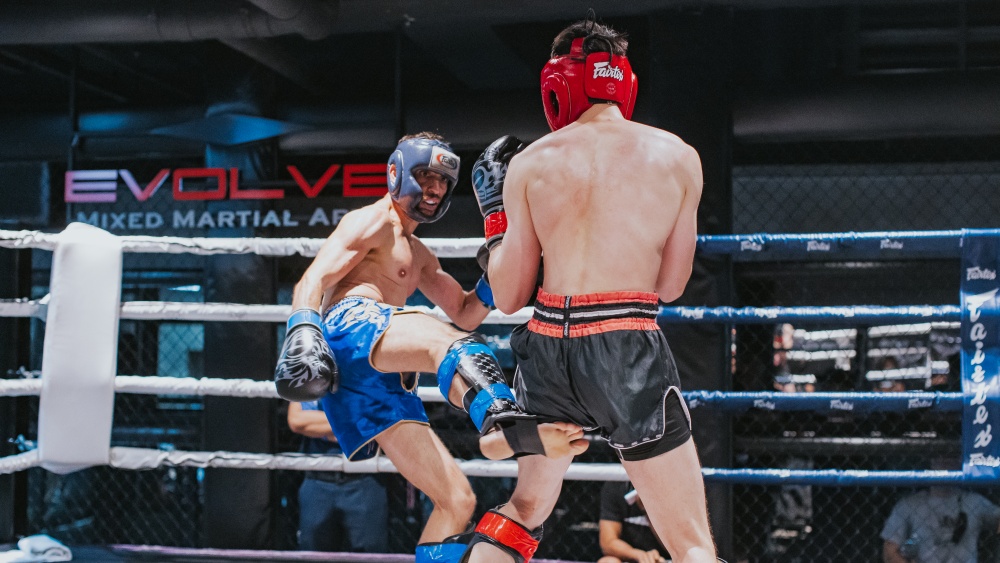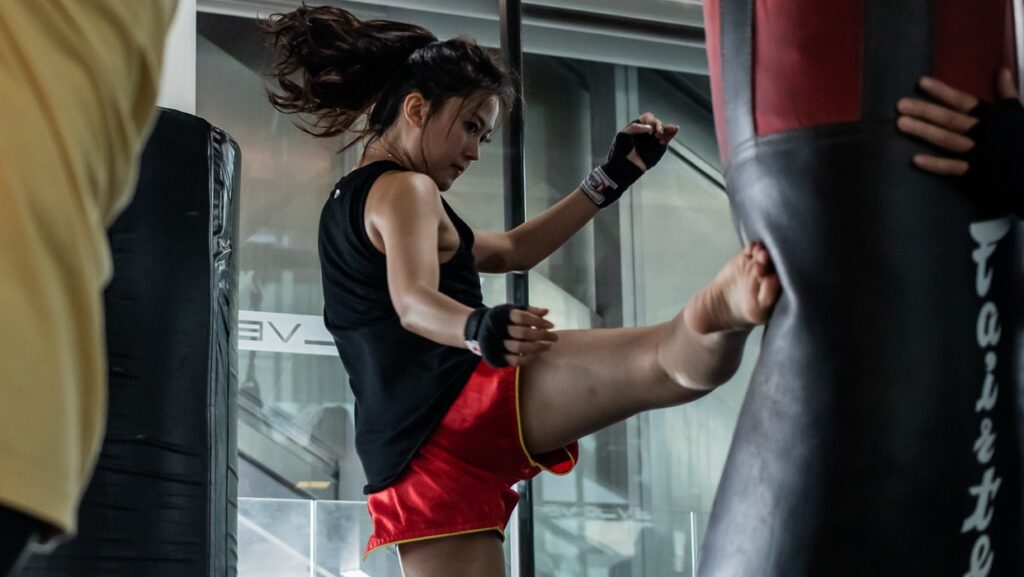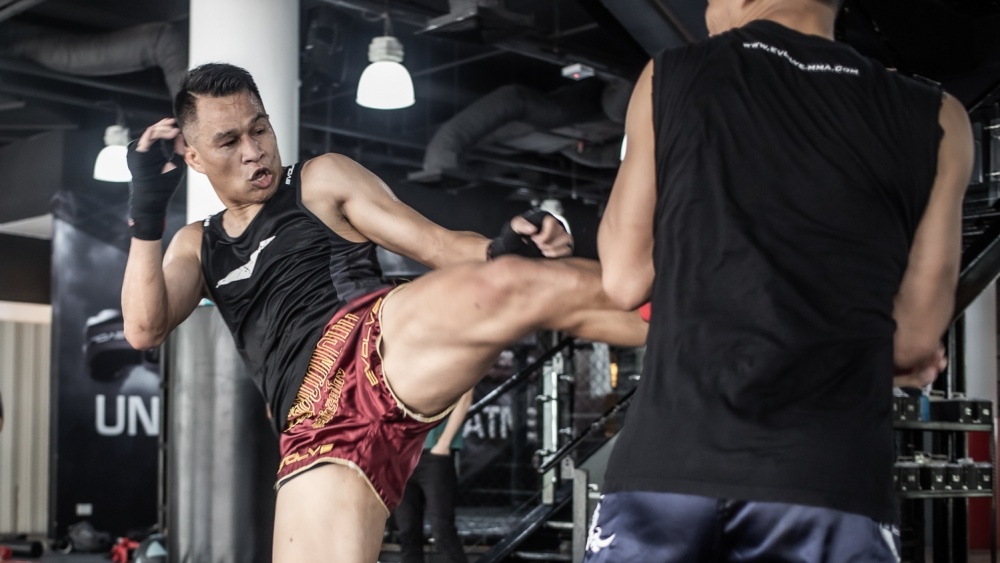Muay Thai is a versatile martial art that allows you to use punches, kicks, elbows, and knees as weapons. This means you’ll also have to learn how to protect yourself against all these strikes. Kicks and knees are some of the most powerful strikes thrown by Muay Thai fighters, and you’ll get hit during your sparring sessions and competitions, regardless of how good your defense is.
Five Things That Improve Your Ability To Absorb Hard Kicks And Other Strikes
You’ll have to build up your body’s ability to absorb the impact of kicks if you plan to compete in Muay Thai. Let’s take a look at some of the ways you can condition your body to better absorb powerful kicks, punches, knees, and elbows.
1) Master The Fundamentals Of Defense
How well you can take a kick won’t matter much if your defense is ineffective. Kicks are the most powerful strikes used in Muay Thai since it’s powered by your legs, which are the strongest part of the body. You won’t last long in a Muay Thai fight if opponents can land powerful kicks on you at will.
Your understanding of the fundamentals of defense is your first course of defense against hard kicks. Some of the ways you can avoid kicks and other strikes include:
- Footwork: Excellent footwork is one of the most effective defenses for kicks. It puts you just out of your opponent’s reach so you don’t take any damage.
- Head Movement: If your footwork isn’t enough to get you out of the way of an incoming kick, a slight movement of your head might be. Move your head laterally to evade straight attacks, while leaning back or dipping down to evade looping attacks. Be careful when dipping down since it leaves you vulnerable to knees.
- Blocking: Blocking a strike reduces the impact it lands with, but you’ll still feel some of its power. Muay Thai fighters typically block low and body kicks by lifting their leg and turning their knee outward. You can also block body strikes by bringing your elbow in or using a Dutch kickboxing-style cross block. Roundhouse kicks can be blocked with the traditional high guard used for punches, but that’s typically not recommended since they sometimes still land with enough force to cause a knockout. You generally want to evade roundhouse kicks to the head, not block them.
2) Stick Training
Stick training is one of the oldest ways Muay Thai fighters have conditioned their bodies to absorb strikes. Boxers like Manny Pacquiao also use stick training to prepare for their fights. There’s not much to stick training, you simply get a training partner to smack your torso and legs repeatedly with a solid wooden rod. Doing so helps to condition nerves all over your body to become desensitized to pain.
It also helps to condition your brain not to panic when you get hit. To get more of your stick training, do it while performing other training-related activities like heavy bag drills, shadowboxing, or focus mitts. You can even add stick training to your sparring sessions.
3) Build Your Outer Armor
You can build up your explosive shell with the right strength and conditioning program. Your explosive shell is the muscles that tighten up right before a strike lands. The more explosive muscle you have all over your body, the stronger this outer shell is.
The key muscles that make up your explosive shell include the latissimus dorsi, obliques, lower back muscles, leg muscles, and abdomen. Build these muscles up with your strength and conditioning program and your ability to take a hard kick will improve. Target these areas when performing other conditioning exercises like stick training as well.
Having strong, muscular legs is particularly important for Muay Thai fighters since low kicks are one of the most used strikes. The stronger your legs are, the more kicks you’ll be able to absorb without your movement being compromised.
4) Teach Yourself To Brace For Impact
It’s not reasonable to expect to be able to dodge or evade every strike thrown your way in Muay Thai. You’ll eventually find yourself in situations where strikes are coming your way, but you don’t have enough time to block or move away from them.
That’s where learning how to brace for impact comes in. The three main things you should focus on when bracing for the impact of a kick or punch include:
- Tightening Your Muscles: Clenching or contracting muscles around the area the strike is headed for provides an extra layer of protection. For example, if a kick is headed for your abdomen, tighten your abs to reduce the risk of internal damage and minimize the pain caused by it.
- Activate Your Leg Muscles: Keeping your foundation solid by tightening your legs and core helps to keep you upright when taking strikes. It makes it easier to stay on your feet and counter.
- Exhale: Breathing out when you absorb strikes reduces the risk of you getting the wind knocked out of you by the strike, which can leave you struggling to breathe. It also tightens your muscles for impact.
Learning how to brace yourself properly for strikes takes some time and practice, but it reduces the damage done by strikes, which, in turn, increases your odds of victory inside the ring. The key to bracing properly is training this reflex to the point it becomes part of your muscle memory.
One simple drill you can use to train to brace is to have a training partner hit your stomach with a medicine ball or pads repeatedly. Ask your partner to start softly if you’re new to this drill, but slowly work your way to full-force strikes. You should also practice bracing whenever your spar so it becomes something you do instinctively when you’re inside the ring.
5) Learn To Stay Loose And Flow
Staying loose and relaxed inside the ring doesn’t mean you should lower your guard and get sloppy. It means keeping your mind and body in a relaxed state so you respond better to hits and stay in the fight.
Flowing refers to moving with strikes when they land. It significantly reduces the force your body has to absorb. Instead of trying to absorb the full force behind a strike, move your body in the same direction as the strike to reduce its effectiveness. You’ll need lots of sparring time to fully develop this skill.
You may also like:
12 Effective Muay Thai Warm-Up Exercises And Stretches To Do Before Training

















